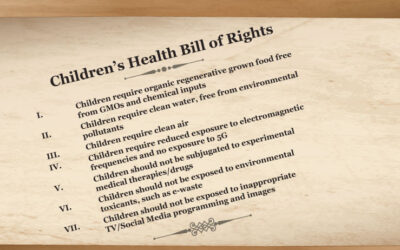In order to reverse the current health crisis affecting children, we need to rethink our relationship with food and the type of medicine we support, says Professor Vincanne Adams.
Vincanne Adams, PhD is professor of medical anthropology at the University of California, San Francisco. Her research interests include the social studies of science, medicine, politics, and culture, and she has worked in Nepal, Tibet, China and the US. Together with a pediatrician, Michelle Perro, MD, she has written a book, What’s Making Our Children Sick? How Industrial Food is Causing and Epidemic of Chronic Illness, and What Parents (and Doctors) Can Do About It, which is available from Amazon.
The book traces the rise of chronic disease in a growing number of children and adults and places much of the blame on industrially produced food, including genetically modified (GM) crops and their associated pesticides. It also explains simple measures that we can all take to restore ourselves and our families to good health.
GMOScience asked Professor Adams what led her to write the book and how working on it has impacted her life.
Q: Why did you write this book?
When I first met Michelle and began to hear about her medical practices and theories of genetically modified (GM) foods in relation to gut health, I was fascinated. Her work touched on many aspects of the work I had done as a medical anthropologist. This included exploring how non-Western medical systems paid more attention to food and ecosystem-wide, holistic approaches to health. I had been writing and teaching for many years about the politics of science, the outsized role of pharmaceutical companies in medical research and clinical care, and how corporations and corporate influences directly and indirectly harm health. I’m trained as an ethnographer, so I’ve devoted my life to writing about the human effects of larger social and structural problems.
I have to confess that when I first heard Michelle talk about GM foods, I was, like many people, quite skeptical. So even though much of what she described in relation to her clinical practices and her perspectives on the failure of modern medicine to deal with chronic diseases was familiar, I was not sure of the science behind the GM food controversy. I started to explore more and to follow her lead into the literature, getting beyond the first layers of controversy. I was amazed at the way these formed a cataclysm of different problems: the failure of modern medicine to take food seriously, the problem of a rise in many chronic health problems, the holes in our regulatory system when it came to food safety and, of course, the controversy over GM foods.
Initially I thought it would be amazing to write a book about Michelle and her integrative practice. Her stories were fascinating and compelling. When I learned that she had for many years wanted to write a book herself, I decided it would be better to write a book together. It has been a great experience learning how to be a collaborator on such a project. It is part description of Michelle’s work and part critical interrogation of the predicament we face today in the face of industrial food.
For my part, I worked hard over the next years to learn as much as possible about the controversial science around GM foods, the empirical evidence on their safety, and the policies and regulatory environments of agroindustrial foods. As a committed ethnographer, I went with Michelle to meetings of organic and non-organic food industry advocates and to conferences of GM food proponents and critics. I read as much of the science as I could. I interviewed physicians and scientists about the phenomena that Michelle had identified. I shadowed Michelle in her clinical practice and together we interviewed her patients so that I could better understand the human and clinical story behind her ideas about these food-health connections. All this information has been collected in the book.
Q: Can you tell us something about how the book turned out and who it is aimed at?
The book offers original materials that connect the dots of our contemporary situation. Beyond the clinical cases, our book maps out the larger contexts and circumstances that have made these foods problematic. It covers how and why medicine tends to seek pharmaceutical over food-based health solutions; how new biomedical research on things like the microbiome, leaky gut or dysbiosis are still a long way from being incorporated into standard practice guidelines and how integrative doctors are breaking the mold; how agrocorporate investments in scientific research have made it hard for insights about the potential harms of GM foods and their associated pesticides to reach the light of day; and how we might think of a future medicine in relation to our ecosystem health – what we call ‘ecomedicine’. I am as much an activist about these problems as I am a documentarian.
Michelle and I had to make the book both convincing and scientifically sound yet at the same time legible and accessible to a wide public. The case studies from Michelle’s clinical work make the book very readable. Also, the case studies describe health problems that are currently suffered by a large number of people, such as allergies, gut problems, and behavioural disorders, so many readers will see their own experiences reflected in the patients’ stories.
All in all, I think that this book is written for a broad audience while not compromising on the quality of scholarship. I hope my academic colleagues will not only find it compelling and convincing but also that they will teach with it and share it with their networks.
Q: Was there anything that stood out or surprised you when you did your research for the book?
One of the things that surprised me about this project was how convinced I became that GM foods and their associated pesticides were a problem. When I began, I honestly didn’t initially think GM foods were as big a problem as Michelle and others made them out to be. However, the more I learned about the theories of chronic illness that were being talked about in the integrative medical world and the amazing assault-like campaigns to dismiss concern over these food technologies, the more I was convinced.
If I had to pick one most surprising insight about this work, however, it would be the degree to which attacks on scientific credibility have not only defined the work on this area, but also penetrated into the communities of opposition to GM foods. So in the first place, the ways in which the agrochemical industries have tried to silence anyone writing against these technologies, going way beyond simple questioning of the science to full blown character assassination, is to my mind evidence of their suspicion that the existing science alone is not convincing enough. Industry’s and industry-paid spokespersons’ steadfast and persistent campaigns to evade criticism and even questioning of the risks are stunning. At the same time, I’ve noticed that similar critiques of “the science” have trickled down into communities that are opposed to GM foods (based on evidence and not simply on politics). I find this fascinating.
Q: Have you made any changes in your own life (diet, etc) as a result of what you learned when writing this book?
Well, although I always felt that organic foods were probably better for me, I never really thought that eating non-organic was potentially dangerous. But now I certainly try to eat only organic. It is clear that harm from foods functions as more of a ‘carrying capacity’ or ‘toxic load’ issue than a straight ‘eat-this-and-you die’ set of measures. Even so, I pay more attention to gut health in general now.
Working on this book has also shifted my perspective on population health and my vision of a society whose health is impaired, or at least less than robust, for the simple reason that our nutrition is compromised. It starts with a variety of things that compromise gut health, from antibiotics to toxicants in the built environment (such as chemicals used in building materials and soft furnishings) and in body and hygiene products, and extends also to the health of the foods we eat. Going beyond the normal culprits like packaged and processed foods, how healthy are our real foods? Then, we need to talk about toxicants like pesticides in our foods, and foods that have been turned into pesticides via genetic modification. We really don’t know much about these in terms of their safety for humans but we have a considerable body of research based on animal studies that is pointing to risks.
Problems of gut health and compromised food systems don’t work to create acute health crises; rather they produce a slow-building low-grade set of chronic problems in the gut that work their way outward to the skin, the immune system, and the brain. Nearly everyone is dealing with some level of problem on this front, I find. Some are more extreme cases than others. When I began to notice this, I sort of panicked and realized that we need an “all hands on deck” approach to solving these problems. We are, as Michelle says, facing a generational crisis of failing health. Our kids are the canaries in the coal mine in this growing epidemic. Food is not the only reason our kids are sick with more chronic conditions than ever before, but it is perhaps the most important piece of the puzzle.
Q: Is there anything else you wish to say?
The problems we are facing in relation to the impacts of GM agroindustrial food technologies are not going to be solved by individuals changing their diets, although the market forces that could drive change should not be overlooked. These problems occur on multiple levels and in ways that require change in relation to policy, research, market systems and governance. We need to change both our concept of public health and the kind of medicine we practice. On top of this, we need to think about how planetary survival really may depend on organic solutions – the opposite of what GM food scientists and agrochemical companies have been saying for several decades. My hope is that this book will help people think about how a healthy body is really only possible in a healthy food environment. In order to bring that about, we need to rethink our paradigms about the relationships between health and food, food and soil, and our bodies and society, or what we call ecomedicine.
What’s Making Our Children Sick? How Industrial Food Is Causing an Epidemic of Chronic Illness, and What Parents (and Doctors) Can Do About It, by Michelle Perro, MD, and Vincanne Adams, PhD, is published by Chelsea Green and available from Amazon:
A Children’s Health Bill of Rights
NOTE: This proposal was first written in November 2021, in response to the myopic and restrictive Covid narrative that was thrust upon children,...



